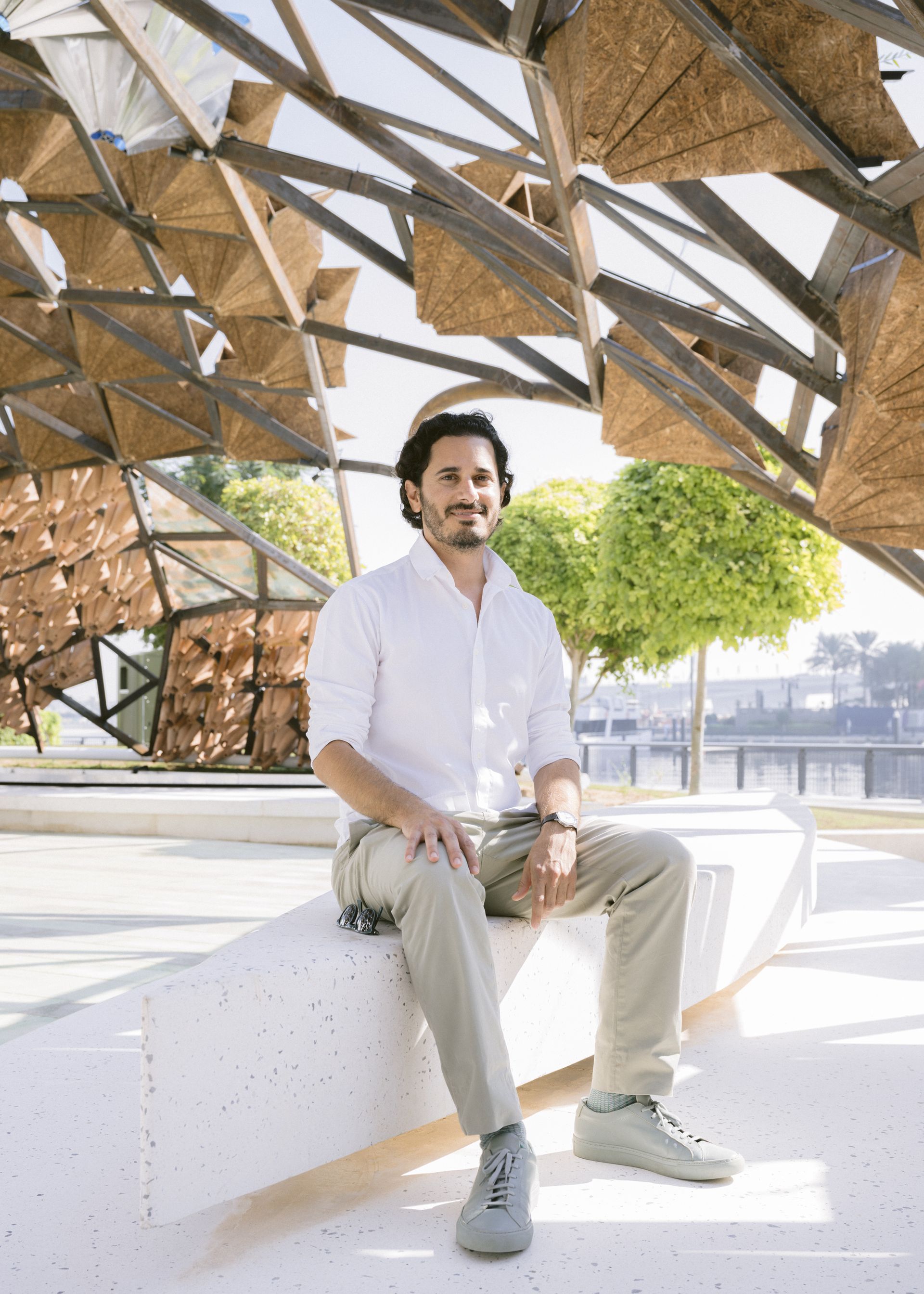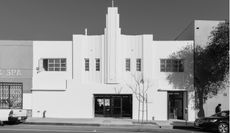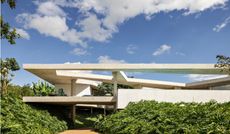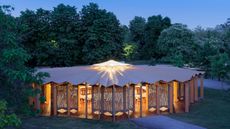Art Jameel pavilion in Dubai is a dome to fight climate doom
Art Jameel pavilion by Lebanese practice theOtherDada flags sustainability in Dubai, and opened to coincide with COP 28

This new Art Jameel pavilion, Tarabot: Weaving a Living Forum, commissioned by the arts organisation and designed by Lebanese practice theOtherDada, is a fractal, domed structure stretching over the amphitheatre at the Jaddaf Waterfront Sculpture Park in Dubai. Weaving together traditional and high technologies, recycled waste materials and indigenous plants, the architectural pavilion aims to bring life to the area over the next five months, forming a new ‘interspecies habitat’.
It sees Art Jameel, which supports artists and creative communities and is behind both the sculpture park and the wider Jameel Arts Centre, promote a conversation about sustainability and re-use.
Founded in 2010 by architect Adib Dada, theOtherDada pushes the boundaries of traditional architecture, adopting a ‘holistic and biomimetic design approach with nature and people at its core’. Reflects Dada, ‘I had these two diametrically opposed practices – building for humans and building for other organisms […] When this commission came along, it became an opportunity to weave these two practices together in a meaningful way.’
Art Jameel pavilion, a study in sustainablity

Deeply involved in contemporary art scenes and climate activism in Beirut, from leading ‘Toxic Tours’ of the Beirut river to developing tree-planting project theOtherForest, Dada was invited to an Art Jameel symposium in March 2023 to discuss the role of arts institutions in addressing the climate crisis.
Art Jameel director Antonia Carver explains, ‘What does it mean to create exhibitions in this climate? What do we do with all the materials after?’ As a direct result of the symposium, Art Jameel has been rethinking its exhibition production processes and reusing waste such as gypsum moulds.
‘Tarabot is an Arabic word that means “weaving together” [...] we’re weaving together issues of architecture, urbanism, ecology, wildlife and human-life centred design,’ says Dada. A lack of shade and life on the pavilion’s site prompted a shade-providing design. Working closely with architect Dalia Hamati, Nader Akoum, scientists, and desert conservationists, Dada conceptualised four life-giving ‘pillars’ – Soil, Water, Plants and Energy – for the pavilion, corresponding to the dome’s three touchpoints with the ground, and its roof.

The first pillar, Soil, makes compost out of waste from the art centre’s exhibitions, neighbouring restaurant Teible and coffee shop. Encased in modular ‘bouquets’ made from local date palm waste, a zero-carbon material, by Desert Board, the waste is broken down by mycelium (the root-like system of fungus).
The Water pillar uses solar power to condense and filter water from the humidity in air. This water drips through a series of traditional passive cooling clay cones, handmade by local potters, collecting as freshwater in the pavilion pool.
The Plants pillar uses the composted soil and collected fresh water to grow vegetables that return to the restaurant. Salicornia, an indigenous edible plant able to grow in saltwater, is also planted, further attracting insects, birds and pollinators. Artwork from multidisciplinary Dubai-based artist Solimar Miller features intricate handcrafted prints on upcycled fabrics, representing indigenous flora and fauna that are endangered in the UAE.
The Energy pillar, on the roof features aluminium cones that funnel sunlight into the pavilion, and Arish, traditional palm-leaf roofing systems provide shade.

Artist Solimar Miller, featuring 24 meters of upcycled cotton fabric, hand silkscreened with branches and leaves from indigenous UAE Ghaf trees, and hand painted with representations indigenous endangered flora and fauna
Almost all materials used in the pavilion are biodegradable or fully recyclable. Once it’s dismantled, the modular cones of soil and plants will be divided and taken to garden homes and balconies by local communities, disseminating indigenous plants in the region. The unfinished steel structure’s fractal design was fine-tuned with local coral practitioners in the Emirate of Fujairah, and the structure will take on new life as an underwater habitat for coral, ‘linking life on land to life underwater’.
On what he hopes visitors will take away from the project, Dada muses, ‘I think developing a culture of care and understanding on the more than human. It’s not about us saving the planet. The planet doesn’t need saving, we need saving.’
Tarabot: Weaving a Living Forum is open to the public at Jadaf Waterfront Sculpture Park, Dubai until 30 April 2024

Architect Adib Dada
Wallpaper* Newsletter
Receive our daily digest of inspiration, escapism and design stories from around the world direct to your inbox
Nana Ama Owusu-Ansah is a writer and photographer from London. She first wrote for Wallpaper* in 2021, in a series on the new vanguard of African designers practising in Africa and its diaspora. She is drawn to projects centring on decolonial approaches to art, architecture, as well as community and sustainability. Nana Ama read Economics and Spanish at University of St Andrews, and, as an avid linguist, is passionate about using accessible language to invite new audiences to engage in design discourse.
-
 Gallery Fumi makes LA debut with works from Max Lamb, Jeremy Anderson and more
Gallery Fumi makes LA debut with works from Max Lamb, Jeremy Anderson and moreFumi LA is the London design gallery’s takeover of Sized Studio, marking its first major US show (until 9 March 2024)
By Tianna Williams Published
-
 Brazil’s Casa Subtração contrasts dramatic concrete brutalism with openness
Brazil’s Casa Subtração contrasts dramatic concrete brutalism with opennessCasa Subtração by FGMF is defined by brutalist concrete and sharp angles that contrast with the green Brazilian landscape
By Ellie Stathaki Published
-
 Level up at the The Residence, Claridge’s new André Fu-designed penthouse
Level up at the The Residence, Claridge’s new André Fu-designed penthouseClaridge’s The Residence is a new purpose-built two-tier glasshouse overlooking London’s skyline
By Lauren Ho Published
-
 Serpentine Pavilion 2024 to be designed by Mass Studies
Serpentine Pavilion 2024 to be designed by Mass StudiesMinsuk Cho and Mass Studies will design the Serpentine Pavilion 2024 in London, it has been announced today
By Ellie Stathaki Published
-
 Installation SUPER LIMBO activates the empty building site of Sharjah Mall
Installation SUPER LIMBO activates the empty building site of Sharjah MallSUPER LIMBO installation by Limbo Accra and Ivorian textile brand Super Yaya uses weaving methods to activate the paused building site of Sharjah Mall during Sharjah Architecture Triennial 2023
By Nana Ama Owusu-Ansah Published
-
 MPavilion 10 by Tadao Ando unveiled in Melbourne
MPavilion 10 by Tadao Ando unveiled in MelbourneMPavilion 10 by Tadao Ando opens to the public in Melbourne, marking the tenth edition of the Australian cultural attraction
By Elias Redstone Published
-
 Sharjah Architecture Triennial 2023 celebrates the ‘beauty of impermanence’
Sharjah Architecture Triennial 2023 celebrates the ‘beauty of impermanence’The Sharjah Architecture Triennial 2023, curated by Tosin Oshinowo, focuses on beauty, impermanence and adaptability; and it has just launched in the UAE
By Ellie Stathaki Last updated
-
 East Architecture Studio, Lebanon and UAE: Wallpaper* Architects’ Directory 2023
East Architecture Studio, Lebanon and UAE: Wallpaper* Architects’ Directory 2023East Architecture Studio, with a base in Lebanon and the UAE, joins the ranks of the Wallpaper* Architects’ Directory 2023, our annual round-up of exciting emerging architecture studios
By Ellie Stathaki Published
-
 The People’s Pavilion 2023 is ‘about the power of the collective’
The People’s Pavilion 2023 is ‘about the power of the collective’The People’s Pavilion 2023 launches at Lea Bridge Library, Waltham Forest in east London – and it’s designed and built by teenagers
By Shawn Adams Published
-
 Serpentine Pavilion 2023 invites everyone to the table
Serpentine Pavilion 2023 invites everyone to the tableThe Serpentine Pavilion 2023 launches to a design by Lina Ghotmeh, whose installation 'À table,' is an invitation to togetherness
By Ellie Stathaki Published
-
 Oberoi Beach Resort, Al-Zorah by Piero Lissoni is an understated UAE gem
Oberoi Beach Resort, Al-Zorah by Piero Lissoni is an understated UAE gemThe Oberoi Beach Resort, Al-Zorah by Piero Lissoni offers beach breaks and contemporary design in the UAE
By Daven Wu Published










